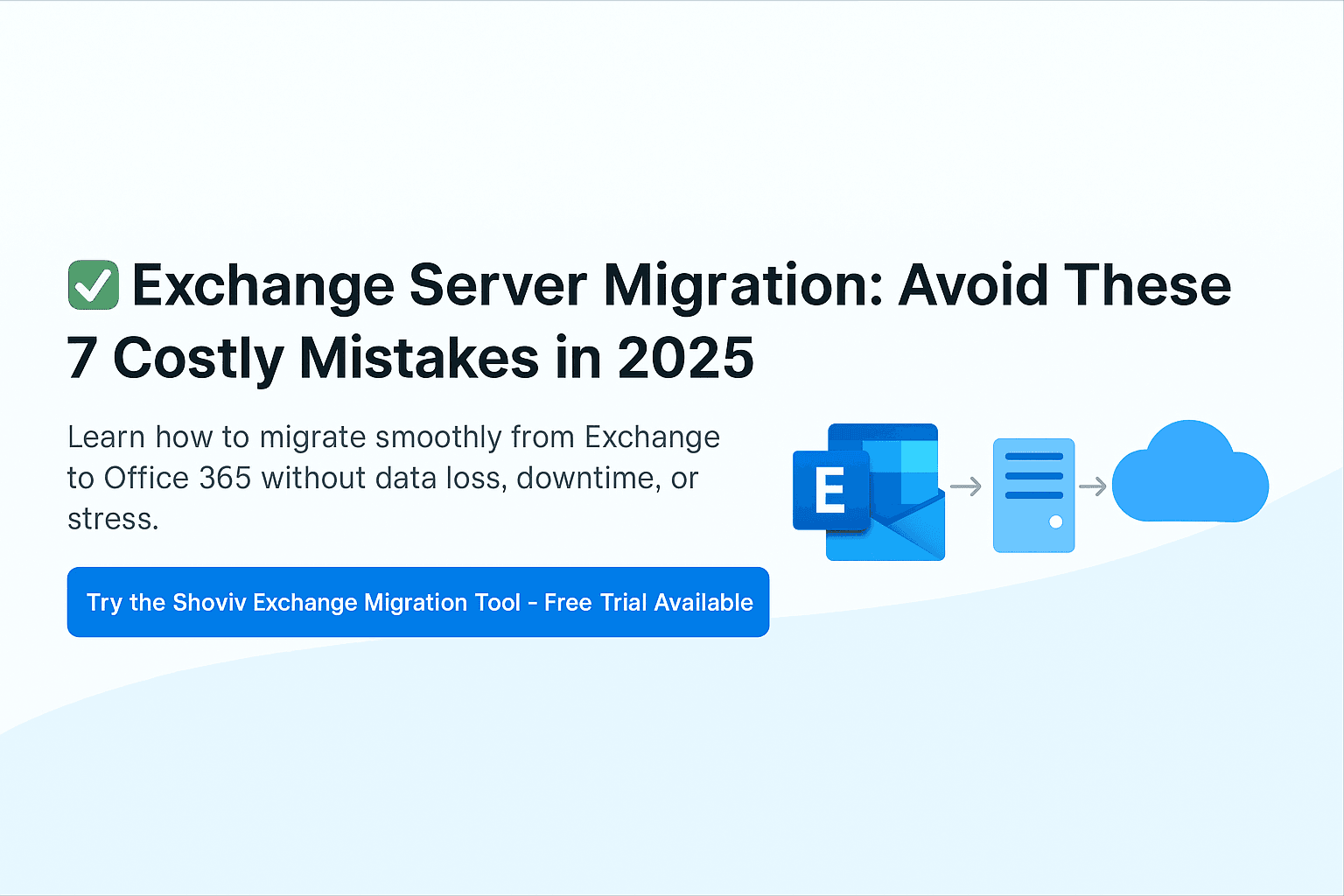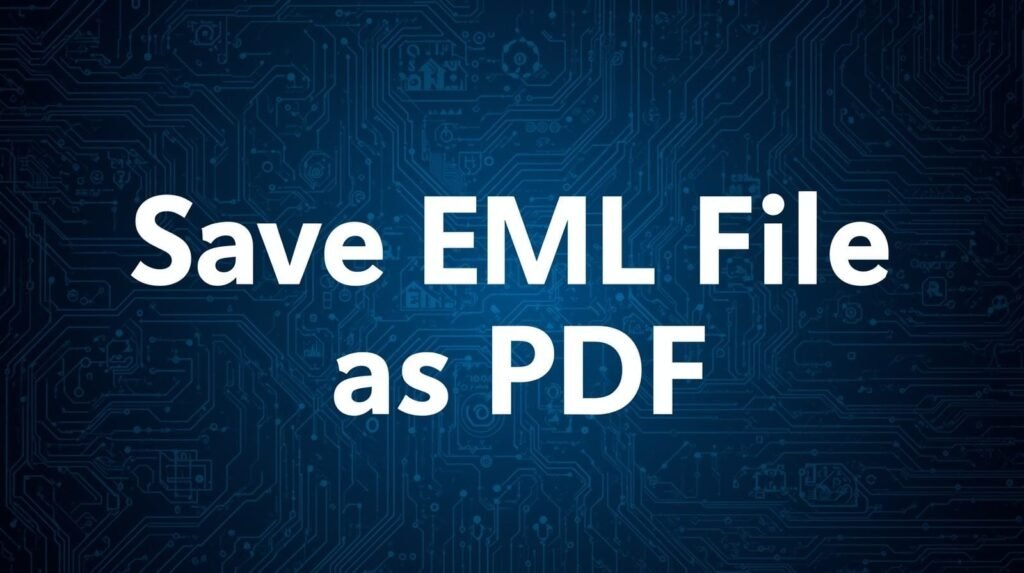Migrating your organization’s mail system from Exchange Server to Office 365 or another platform is no small task. While cloud adoption continues to rise in 2025, many IT teams still face unexpected roadblocks during Exchange Server migration, leading to data loss, delays, or user frustration.
The good news? Most of these issues are avoidable with the right planning, tools, and mindset.
In this post, we’ll walk you through 7 costly mistakes you should steer clear of during your Exchange migration and how to avoid them, whether you’re handling it in-house or using a third-party Exchange Migration Tool like Shoviv.
Mistake #1: Diving in Without a Clear Migration Plan
One of the most common (and avoidable) mistakes is jumping into migration without a detailed plan.
Why it’s risky:
Without a clear roadmap, you may overlook critical steps like setting up DNS records properly, calculating mailbox sizes, or managing user expectations. The result? Downtime, confusion, and even data loss.
What to do instead:
- List all mailboxes, shared mailboxes, and public folders.
- Define your target environment (e.g., Microsoft 365, newer Exchange version).
- Outline phases: pre-migration, pilot, full migration, post-migration.
- Set up a user communication strategy.
A good plan can save you from a bad experience.
Mistake #2: Choosing the Wrong Type of Migration
When it comes to Exchange migration, one size doesn’t fit all.
Why it’s risky:
Picking the wrong approach (Cutover, Staged, or Hybrid) can lead to broken mail flow, lost calendar sharing, or a forced weekend rush migration.
What to do instead:
Understand your options:
- Cutover migration: Best for small organizations with <150 mailboxes.
- Staged migration: Good for larger mailboxes and phased moves.
- Hybrid migration: Ideal for long-term coexistence or gradual transitions.
Shoviv Exchange Migration Tool supports all of these models, giving you flexibility based on your organization’s size and goals.
Mistake #3: Skipping Pre-Migration Cleanups & Checks
Imagine migrating outdated, oversized, or corrupted mailboxes—it’s a mess.
Why it’s risky:
Old mailboxes with unused data or corrupted items can slow down your migration, cause sync errors, or result in failed mailbox moves.
What to do instead:
- Clean up unused or inactive mailboxes.
- Archive or delete unnecessary emails.
- Run health checks on Exchange databases.
- Ensure client machines and Outlook versions are updated.
Mistake #4: Underestimating Mailbox Size & Microsoft 365 Throttling
Mailbox size matters especially during migration.
Why it’s risky:
Large mailboxes can take hours (or days) to move. On top of that, Microsoft 365 has throttling policies to prevent data overload, which slows everything down.
What to do instead:
- Break down mailbox moves into manageable batches.
- Use a migration tool that supports incremental migration (like Shoviv).
- Migrate during off-peak hours to avoid performance slowdowns.
- Monitor transfer rates and retry failures gracefully.
Mistake #5: Ignoring Permissions and Shared Resources
Mailbox data is only half the story permissions matter just as much.
Why it’s risky:
Post-migration, users might lose access to shared mailboxes, calendars, or folders, causing panic and a flood of support tickets.
What to do instead:
- Make sure mailbox delegation, folder permissions, and access controls are replicated.
- Test permissions before switching over to the new system.
- Choose tools that migrate not just data but permissions and folder structures too.
Mistake #6: Not Having a Backup or Rollback Strategy
Even with the best intentions, things can go wrong. And when they do—you need a plan B.
Why it’s risky:
If your migration fails midway or some data goes missing, without a backup or rollback strategy, you’re in deep trouble.
What to do instead:
- Always back up your mailboxes before starting.
- Document your source and target environments.
- If you’re using third-party tools, ensure they maintain mailbox integrity.
- Test restores in a non-production environment.
Shoviv, for example, ensures data integrity and offers incremental updates to re-migrate only new or changed items—ideal for rollback and retry scenarios.
Mistake #7: Trying to Do It All Manually
PowerShell scripts and manual exports might work for small organizations—but they don’t scale well.
Why it’s risky:
Manual migrations are time-consuming, error-prone, and require deep technical knowledge. One missed command can corrupt an entire mailbox.
What to do instead:
Use a reliable Exchange Migration Tool that simplifies the job. A good tool will:
- Automatically map mailboxes
- Support source-to-target validation
- Perform delta (incremental) migrations
- Maintain folder structure and metadata
- Show real-time progress and error reports
The Shoviv Exchange Migration Tool is trusted by IT admins for exactly these reasons—plus, it’s user-friendly and scalable.
Final Thoughts: Migrate Smart, Not Hard
Exchange Server migration doesn’t have to be painful—if you’re prepared. Avoiding these common mistakes will not only save time and money but also make life easier for your IT team and users.
Whether you’re migrating from Exchange 2013, 2016, 2019, or heading straight into the cloud with Office 365, be sure to:
- Plan ahead
- Test everything
- Use the right tools
And if you’re looking for a smooth, secure, and scalable solution, the Shoviv Exchange Migration Tool can help you handle migrations confidently—from small businesses to enterprise environments.
Have Questions?
We’d love to hear about your migration experience or challenges. Feel free to connect with us or try the free trial version of Shoviv to explore its features firsthand.
FAQ: Exchange Server Migration in 2025
Q1: What is the best way to migrate from Exchange to Office 365?
A: The best method depends on your organization’s size and goals. For small setups, a cutover migration may work. Larger or hybrid environments often need professional tools like Shoviv Exchange Migration Tool to manage mailbox mapping, incremental sync, and permissions.
Q2: Can I migrate Exchange 2013 or 2016 directly to Microsoft 365 in 2025?
A: Yes, you can. However, Exchange 2013 is already out of support, so using a secure and up-to-date migration tool is highly recommended for a smooth and safe transfer.
Q3: What are the common challenges during Exchange migration?
A: Common issues include throttling, mailbox size limits, broken permissions, DNS misconfigurations, and lack of rollback options. Using a comprehensive tool reduces the risk significantly.
Q4: How long does Exchange migration take?
A: It depends on mailbox size, internet speed, throttling limits, and your chosen method. With a reliable tool like Shoviv, you can perform bulk migrations efficiently and even use scheduling and delta (incremental) migration to manage time better.
Q5: Why should I use a third-party Exchange migration tool like Shoviv?
A: Manual methods are prone to errors, are slower, and need technical expertise. Shoviv simplifies the entire process—offering an intuitive interface, high-speed transfer, mailbox auto-mapping, and detailed reports to ensure no data is left behind.








Leave a Reply